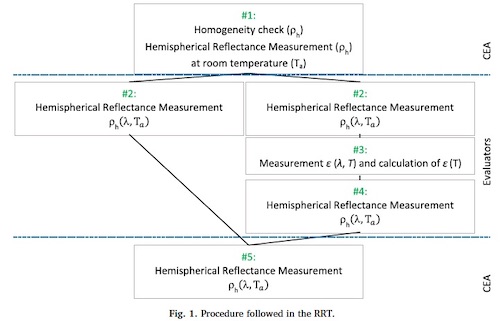Ask for a reprint
email :
* Give your email
2019
ACL
|
E.Le Baron, O.Raccurt, P.Giraud, M.Adier, J.Barriga, B.Diaz, P.Echegut, D.De Sousa Meneses, C.Capiani, D.Sciti, A.Soum-Glaude, C.Escape, I.Jerman, G.A.López, T.Echániz, M.J.Tello, F.Matino, A.Maccari, L.Mercatelli, E.Sani, 'Round Robin Test for the comparison of spectral emittance measurement apparatuses', Solar En. Mat. Solar Cells 191 476-485 (2019) doi:10.1016/j.solmat.2018.11.026
CSP (Concentrated Solar Power) plants technologies use the concentration of solar energy on a receiver to produce heat and then electricity by a thermodynamical process. A solar absorber material is used to convert the energy carried by light into heat. This type of material works at high temperatures (up to 1000 °C) under a highly concentrated solar flux (up to x1000 or more). Optical properties determine the performance of absorbers and it is thus necessary to measure their spectral absorptance and emittance. Solar absorptance is directly linked to the capacity of the absorber material to convert the solar flux into heat. Emittance drives the radiative thermal losses for the heated absorber and depends on the absorber temperature. The characterization of a material in operational conditions at high temperatures requires advanced apparatuses, and different measurement methods exist for the characterization of these two quantities of relevance regarding an absorber. A Round Robin Test (RRT) was conducted with the objective of comparing different new optical apparatuses and methods for measuring the emittance or luminance of various solar absorbers in air. Measurements were carried out directly at temperatures up to 560 °C while heating the samples, and also indirectly by hemispherical reflectance measurements at room temperature. In this paper, the Round Robin Test procedure to compare apparatuses is described, as well as the corresponding reflectance and emittance results on four types of materials. In addition, a discussion of some factors of influence over high temperature measurements in air and of the observed discrepancies among results from the evaluators is presented. The reliability of reflectance/emittance measurements is also demonstrated and statistics of deviations from the mean value are analysed. These allow us to infer information about measurement reproducibility. The reflectance spectra of all samples after high temperature measurements in air (up to 500 °C) do not show any significant changes.
|

|